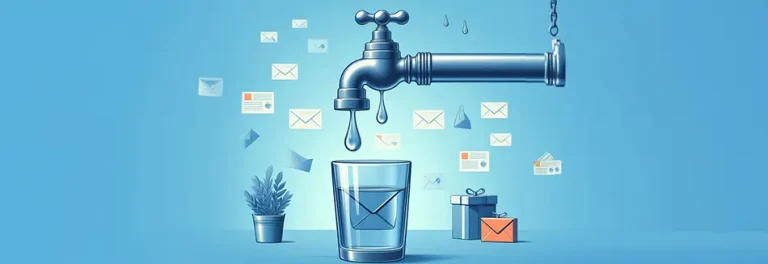Email drip campaign means sending emails in sequence to a certain audience, within a planned schedule.
This strategy is designed to nurture leads, educate customers and also guide them through the buying journey with personalized and relevant content.
When implemented well, an email drip campaign can improve engagement, strengthen customer relationships and boost sales.
In this article, we’ll explore the fundamentals of this technique, its advantages and how to implement it successfully to transform your digital marketing strategies.

Table of contents
Examples of situations in which an email drip campaign is used
Drip campaigns can be used in a variety of situations to nurture leads, educate customers, increase engagement and more.
Here are some common examples of when and how an email drip campaign can be effective:
Lead nurturing
- After signing up for a newsletter: sending an email drip campaign with relevant content keeps the lead interested and guides them through the marketing funnel.
- Emails after downloading an ebook: offering additional information and content related to the topic of the downloaded ebook is an opportunity to create a closer relationship with the lead who is interested in that subject.
Onboarding de clientes
- Customers of physical products or online services: instruct customers on the best ways to use the product they have purchased. For customers of online services, present the first steps and best practices in order to get the most out of the contracted service.
Customer education
- Updates and improvements: keeping customers up to date on improvements and new features of the products they already use.
- New product launches: informing customers about new products and their features.
Email drip campaign without e-commerce
- Abandoned cart recovery: those working in e-commerce should send reminder emails and incentives, such as discounts or free shipping, so that the customer feels encouraged to complete the purchase.
Re-engaging inactive customers
- Old customers: send personalized emails with special offers or interesting content to reactivate the interest of customers who have not interacted recently.
Note that an email drip campaign is useful in the middle of the funnel and post-sale, as this strategy aims to consolidate the relationship with leads and/or customers.
What are the advantages of using this strategy?
Drip campaigns can significantly improve communication with customers, increase marketing efficiency and boost sales.
Starting with lead nurturing, the drip strategy promotes continuous engagement throughout the sending of emails, through useful and relevant content.
In this way, the public stays connected to the brand/company, reducing the time it takes to make a purchasing decision.
Conversion rates increase as a result, as the campaigns educate and qualify the lead.
Step by step to create an effective email drip campaign
To generate an email drip campaign, you need detailed planning of the sending flow, as well as knowledge of your target audience and the use of the right tools.
Here’s a basic step-by-step guide, bearing in mind that marketing needs vary, and with them, each plan is unique.
1. Defining objectives and knowing your audience
What are the goals of your email drip campaign? To increase sales? Generate leads? Nurture prospects? Retain customers? Having clear objectives will help direct all subsequent steps.
Create your persona and understand their needs and behaviors. The more you know about your audience, the more personalized and effective your campaign will be.
2. Segmenting contact lists
Using an automation platform (which is indispensable for applying an email drip campaign), separate your lists based on criteria such as interests, previous behaviors, stage in the sales funnel, among others. This will allow you to send more relevant messages to each group.
Remember the quality of your mailing lists
But before implementing this or any other email marketing strategy, your mailing list needs to be clean.
In other words, the mailing list the professional will be working with must be free of invalid emails and bounces, and this can only be achieved by using an email verification tool.
This way, email marketing senders don’t have their campaigns blocked by the spam filters of the recipients’ providers, which block lists containing up to 3% bounces, regardless of whether there are a thousand or 10 thousand contacts.
3. Customer journey planning
Planning an email drip campaign consists of developing a logical sequence of messages that will guide your leads through the buying journey. Define which content will be sent at each stage and make sure that each message has a clear purpose.
4. Create interactive content to engage
Develop valuable and relevant content for each stage of the drip campaign. Your emails should be informative, engaging and aligned with the interests and needs of your target audience.
It is worth highlighting the email signature space, which is very important so that the lead can associate the message communications with the brand’s visual programming.
It is also a strategic place in the email structure that can be used to promote engagement, through exclusive promotions, links and CTAs.
5. Personalize your messages
Whenever possible, personalize your messages with the recipient’s name and other relevant information. Personalization increases engagement and improves the effectiveness of the campaign.
6. Heads and otimize his email drip campaign
Carry out A/B tests for different elements of your emails, such as subject lines, design and call to actions. Analyze the results and adjust your campaign based on performance.
7. Monitor and analyze results
Track your campaign’s performance metrics, such as open rates, clicks, conversions and unsubscribes. Use this data to evaluate the effectiveness of your campaign and make continuous improvements.
8. Adjust your email drip campaign as necessary
Based on the analysis of the results, make adjustments to your campaign. Learn from what worked and what didn’t in order to optimize future actions.
This way, your next campaigns will be even more assertive, increasing the chances of conversion and building lasting relationships with your customers.
Best practices for email drip campaigns
Create attractive, short and relevant subject lines that arouse curiosity and encourage people to open the email.
Make sure your emails are responsive and visually appealing on mobile devices. In other words, the use of smartphones by a large proportion of users can become a poor experience, culminating in low engagement rates if there is no responsiveness.
Find a balance in the frequency of your emails. Sending messages too often can irritate recipients and increase the unsubscribe rate, while sending too few can make them forget about you.
Keep your contact list up to date by removing inactive and invalid addresses. A clean list improves email deliverability and ensures that you are reaching an engaged audience.
Make sure your campaign complies with data protection laws. This includes Brazil, with the LGPD, and the EU, with the GDPR, if your email drip campaign is sent to European prospects/customers.
Include a clear unsubscribe option in all emails and respect your contacts’ privacy.

FAQ
What is an email drip campaign and what is it for?
Email drip campaign, also known as drip campaign, is the sequential sending of emails, with the aim of fulfilling a planned flow schedule. This type of campaign is very useful for creating and maintaining relationships with leads and/or customers in various ways.
What can go against good practice in a drip campaign?
Non-compliance with Data Protection laws is a serious problem, which can lead email senders to strict sanctions and fines.
The absence of an email verification service is also very damaging, as senders’ reputations are at stake, and polluted lists (full of bounces and invalid emails) hit senders’ credibility hard with recipients’ ISPs.



